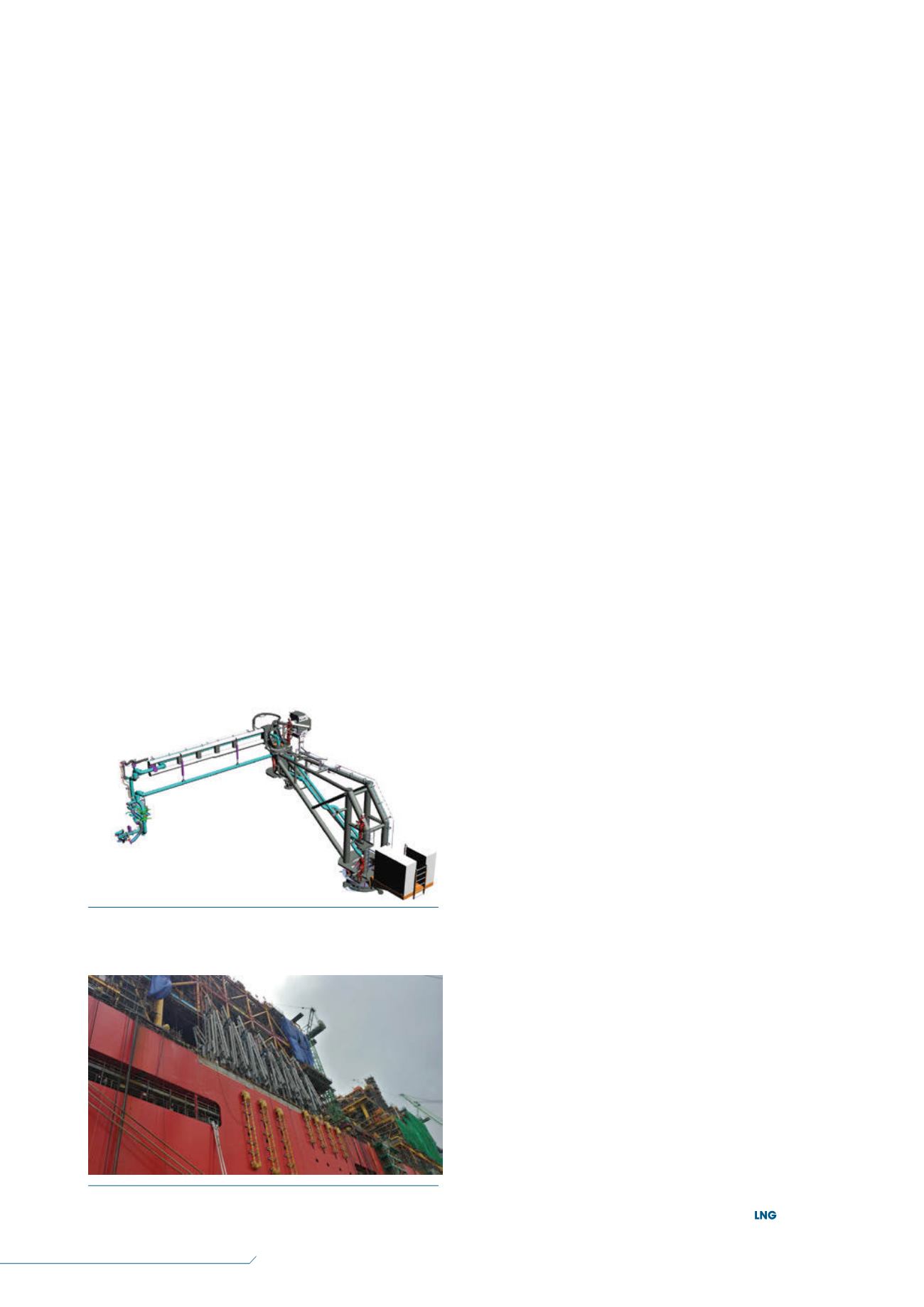
44
LNG
INDUSTRY
MARCH
2016
This is opposed to conventional onshore terminals where there
is usually a split between supply of the offloading equipment
and aftermarket services.
From side-by-side to tandem
systems
Operation of offshore gas fields in harsh environments, as
well as the flexibility to relocate an existing FLNG vessel
to any location in the world, naturally led FLNG project
owners to look at LNG tandem offloading as a natural way to
offload oil from a floating production storage and offloading
(FPSO) unit. Previously, the lack of maturity of LNG tandem
offloading technologies proved problematic, but the latest
developments made on the FMC Articulated Tandem Offshore
Loader (ATOL), in partnership with oil and gas majors, dynamic
positioning (DP) suppliers and LNG carrier operators, make
such operations possible.
The FMC ATOL has not only been validated through
comprehensive kinematic, stress and fatigue analysis to
confirm a 99+% operability in the harshest Australian type
conditions, it has also been fully validated thanks to a one-fifth
scale model, tested under the harshest environmental
conditions with third party involvement.
Field-proven component design and technologies from
onshore LNG loading arms, as well as offshore side-by-side
LNG transfer with loading arms, are transposed to the ATOL
LNG tandem transfer solution and were prototype-tested to
real project conditions. For instance, the FMC ATOL swivel
joint successfully passed a long life test equivalent to a 10-year
maintenance-free period (considering one offloading per
week). In addition to this, a consolidated execution plan has
been developed detailing a 24 – 30 month delivery time,
including project specific engineering, purchasing, construction
and tests. As part of this execution plan, the FMC ATOL
emphasises the turnkey approach, minimising the integration
works duration on the FLNG unit to a strictly limited number of
mechanical and electrical interfaces. This all-in-one design
allows for extensive tests to be performed on the ATOL before
its delivery, inclusive of functional, static and dynamic tests
and simulations of emergency disconnections.
Comprehensive engineering studies and compliance with
the stringent expectations of offshore conditions, as well as
the full operability of the offloading system, must be
considered to maintain the performance levels. This requires
the operators to be trained to operate in a safe and
appropriate manner, and to maintain the equipment in fully
operable conditions by performing inspection and
maintenance as required.
LNG bunkering operations
Offshore offloading systems for both side-by-side and tandem
configurations are designed to deliver three main objectives
– the safety, reliability and performance of the operations.
The same objectives are also considered for LNG bunkering
operations, but are realised in a different context. LNG bunkering
is at a junction between conventional fuelling and LNG transfer,
and involves users who are unfamiliar with LNG handling and
transfer. Any major incidents/accidents will dramatically impact
the full LNG chain and market. Therefore, it is important that
LNG specialists are involved to ensure the market’s safe and
sustainable development, and to maintain the LNG industry’s
outstanding safety record achieved over the past 50 years.
LNG bunkering infrastructures are developed to supply
LNG-fuelled vessels, either from shore bunkering stations or
bunkering vessels. Loading arm technologies offer numerous
benefits, including the following:
Safety: based on rigid pipes resistant to fire, together with
field proven swivel joint technology, the loading arms are
associated with an ESD management system, allowing
disconnection in a quick and safe manner, mirroring
conventional LNG transfer.
Flexibility: depending on the range of LNG-fuelled vessels
to be bunkered, the offloading systems can be adapted to
cope with a wide or narrow operating envelope.
Operability and maintenance: rigid pipes offer limited
pressure loss and higher flowrate capabilities. In addition,
the ability to quickly drain the loading arm, or to maintain
it at cold temperature, saves time between bunkering
operations and increases the offloading frequency.
As each project is different, customised offloading
solutions are an excellent approach for a cost-effective
outcome. The design of the first LNG bunkering loading arm
was based on this. The bunkering vessel will be operated by
Shell in the port of Rotterdam, the Netherlands.
Conclusion
Safety, reliability and performance are essential considerations
for the design of onshore terminals, FSRUs, FLNG vessels
or LNG bunkering stations. A maintenance programme is
essential to maintain these three factors during the lifetime
of an offloading system. As each application and project are
different, the design and operation management programme
should be customised to reflect their particular specifications
to provide the most effective CAPEX and OPEX.
Figure 4.
OLAF offshore loading arms installed on Shell’s
Prelude
FLNG facility.
Figure 3.
LNG bunkering arm installed on a vessel.


